Your cart is currently empty!
Can you Keep a Kiln Outside? – 4 Key Factors to Consider
Published:
Last Updated:
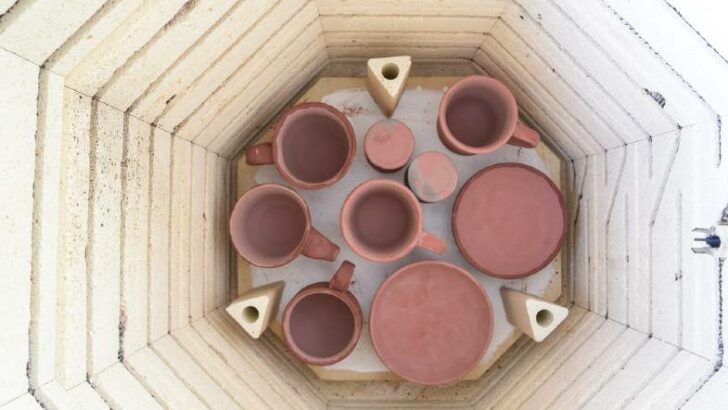
Affiliate Disclaimer
As an affiliate, we may earn a commission from qualifying purchases. We get commissions for purchases made through links on this website from Amazon and other third parties.
When I was starting to build my pottery workshop, I encountered the thorny issue of where to keep my kiln. I don’t have a lot of space and I wanted to build a workshop in the backyard. One of the questions I had was, can you keep a kiln outside? Here is what I learned…
If you want to keep a kiln outside, you need to protect it from the elements. You also need to have enough space for the kiln to have sufficient clearance and ventilation. Ideally, it needs to be situated near an outdoor electrical outlet rather than using an extension lead.
In an ideal world, I would have my kiln indoors. But as we all know, you can’t always get what you want. I don’t have a lot of space, and kilns are bulky. So, what is the solution?
Whilst lots of potters do keep their kilns outside, others are dead against it, arguing that it’s unsafe and unwise. As I said, it’s a thorny issue. In this article, I will look at some of the important factors that need to be taken into consideration. So that you can decide whether it is the right solution for you.
Can You Keep a Kiln Outside? -Factors to Consider
In this article, I’m talking largely about electric kilns. These are by far the most commonly used kiln. Nevertheless, some of the issues that are covered also apply to gas kilns. The problems that are related to electrical wiring, are obviously not an issue for a gas kiln. But other factors such as corrosion are relevant for gas kiln users.
That being said, here are some of the important factors to consider if you want to keep a kiln outside.
Factor 1: The Weather – What Kind of Climate Do You Live in?
Talking about the weather is dull. However, if you are wondering if you can keep a kiln outside, it is a factor you need to consider. Here are some of the ways that the elements can mess with your elements!
Rain, Damp, and Humidity
Kilns and wet weather do not mix. There are a few reasons for this.
The first and most obvious danger is that electricity and water are a dangerous combination. Most suppliers state unequivocally that kilns must be kept dry. And that if a kiln gets wet it poses an electrocution hazard1.
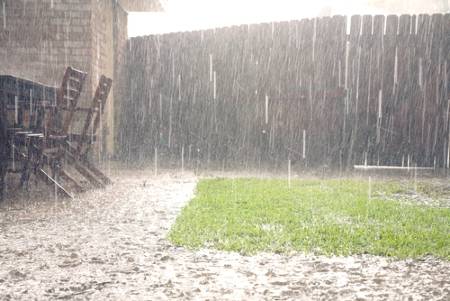
In addition to this danger, water humidity and dampness can cause rust and corrosion on a kiln. This corrosion can affect the outside ‘skin’ of the kiln, the electrical elements, and the components in the controller.
Corrosion can cause your kiln to stop working. Often problems caused by corrosion are intermittent, which means that they are hard to troubleshoot.
Another difficulty that arises from a wet environment is that the soft insulating bricks used in a kiln are absorbent. They soak up moisture like a sponge. This can be moisture in the atmosphere from a rainy environment or a humid climate. Either way, damp kiln bricks are an issue.
If the kiln bricks get damp you can get rid of the moisture by candling for a few hours. Even inside, there is always a level of moisture in the atmosphere, that will be absorbed by kiln bricks. This will evaporate as the kiln heats up.
However, this can be problematic if there is significant moisture, like the kind that from a regular morning dew outside. Kiln bricks that absorb a lot of water in a humid atmosphere can cause corrosion and problems when firing.
It’s also worth remembering that generally damage to a kiln caused by bad weather is not covered by the warranty.
Cold Weather
If you live in an area that gets very cold, your kiln may not function if it is outside. Kilns do not like temperatures that drop below 32 F (0C).
It is generally recommended that kilns are operated somewhere between 105 and 32 F (40.5-0 C).
Skutt specifies that the maximum temperature of the room should be 100F (38C). And the minimum Operating temperature is 33F (1 C)2.
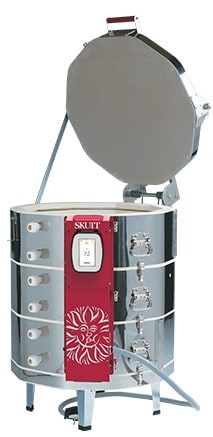
Skutt KMT 1027 – view on Blick
If the temperature drops below 32F, then you will likely find that the digital controller display will lock and malfunction.
This is a problem for kilns that are outside. In a very cold studio, you can, of course, warm up the room temperature with a space heater.
Once the room is above 32F you can turn the kiln on. And as the kiln heats up, you can turn the space heater off.
However, this is obviously not an option if your kiln is outside. Some potters who live in cold climates and who have their kilns outside, simply stop firing during the wintertime. There are however some other solutions that I will look at below.
Hot Weather
Very hot weather can also be a problem for operating a kiln. If a kiln is in direct sunlight, or in very hot weather there is a risk that it might overheat. In this case, the kiln or the digital controller might stop working.
Windy Weather
Some potters keep a kiln outside on the porch or under a lean-to. If you are considering doing this, it’s good to be aware of wind blowing rain under the awning. Is the covered area large enough to prevent rain from being blown onto your kiln?
Also, wind can blow leaves, and debris onto, under, or near your kiln. It’s important to avoid flammable debris from being swept up by the wind into contact with the kiln.
Factor 2: Your Electricity Supply
You need to check with the kiln supplier what kind of electrical supply will support your kiln. Broadly speaking kilns fall into two categories. These are the smaller kilns that you can plug into a domestic electrical outlet. And larger kilns that need to be wired in by an electrician.
Regardless of whether you have a plug-in or a wire in kiln, your electrical supply will need consideration. Even if you have a plug-in kiln, many suppliers will specify that you should not use an extension lead. Instead, they recommend putting an outlet close to the kiln.
This will enable you to plug the kiln in with the power cord it came with. Using an extension lead can cause overheating, power failure, and fires.
Nevertheless, some potters do use extension leads. If they choose to do this, they use heavy-duty extension leads that can handle the power a kiln requires.
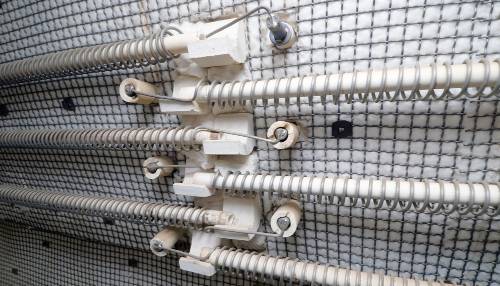
The longer the distance between the mains box and your kiln, the heavier the wire will need to be. This is because, the further the electrical supply has to travel, the more power loss that will occur.
One way to keep the cable length down is to install a permanent outdoor electrical outlet. This will help you avoid having to run a heavy-duty cable out of a window or door.
Consult With an Electrician
An electrician would be able to advise you what, if any, kind of extension lead you could use.
It is generally advised that you consult with the kiln supplier and electrician when considering how to power your kiln. This is one step you may need to take to make sure your kiln setup doesn’t invalidate your insurance.
You should also check whether you need an electrical permit in your location to cover any wiring installation or alteration3.
Factor 3: Check With Local Building Control
If you plan to keep a kiln outside, it is recommended that you check with local building officials. It’s important to be sure that you are meeting local building codes.
Having a kiln outside may break local code. One of the reasons for this is that the surface of a kiln gets very hot when it is firing. There is a danger that a child, animal, or unsuspecting adult may burn themselves on the kiln.
So, there is a lot to bear in mind if you want to keep a kiln outside. That being said, perhaps having your kiln outside is your best option. If that’s the case, and you want to know how some potters have their kilns outdoors, then read on…
Factor 4: How to Keep a Kiln Outside
Here are some ways that potters keep their kiln outdoors. I would stress that these suggestions are for information only. You would need to ensure that you are meeting the recommended safety requirements. And also, that you are protecting yourself and your kiln.
Covering Your Kiln
Some potters keep their kiln outside and cover it with a tarpaulin when they are not using it. However, if the tarpaulin is sitting directly against the side of the kiln, condensation on the tarp can cause corrosion.
One solution is to build a frame so that the tarp sits on the frame rather than directly on the kiln. With this arrangement, you still risk drips of moisture build-up from the tarp.
A solution to the issue of condensation is to use a cover that is designed to protect outdoor equipment. Some potters cover their kiln with grill covers or car covers.
However, covering your kiln in this way is a minimal arrangement. Even if you are happy with this, you need to think about what ground your kiln is sitting on. Is it protected from moisture and wet on the ground?
Lean-Tos, Carports and Porch’s
It is also quite common for potters to have their kiln outside in a semi-covered awning. Some examples are lean-tos, carports, and porches.
The advantage of these is that they are better at keeping off the rain. They also provide some protection from extreme cold and some shade from the sun.
There are plenty of safety considerations to bear in mind if you are planning to use an awning like this. As with using a kiln indoors, you need to have plenty of clearance between the kiln and surrounding walls.
This is particularly relevant if you are thinking of having your kiln on your porch. It’s important that it isn’t too close to the wall of your home.
Generally, kiln suppliers recommend 18” clearance between a kiln and any walls or nearby objects.
If you’re using a carport, then you just need to make sure that there is enough clearance above the kiln.
It is important that there is nothing flammable nearby. And the kiln needs to be positioned on a suitable surface. For a full listing of the installation safety requirements, you should consult your supplier’s user manual for your particular kiln.
Kiln on Caster Wheels?
Another option is to store your kiln inside when you are not using it. If the kiln is on casters, you can wheel it outside when you are firing. Skutt makes a rolling kiln stand for this purpose. Here it is:
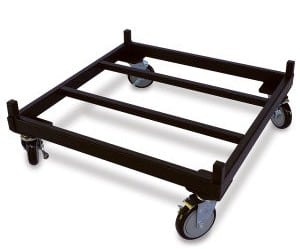
The Skutt Rolling Kiln Stand – View on Blick Arts
It’s designed to withstand high temperatures and support the weight of the kiln. Also, they make it in different sizes to fit 8, 10, and 12-sided kilns.
Some potters store their kiln in the garage. Then, when they want to fire it up, they open the garage door and wheel it under the open door. That way the kiln is protected if it rains, but there is more ventilation.
It’s worth mentioning that kiln fumes can corrode paintwork on cars. Even if you wheel your kiln to an open garage door, some fumes may enter the garage.
One issue with wheeling a kiln about on casters is that it can increase the chances of the kiln bricks cracking. The insulating bricks in a kiln are very fragile and break easily. The bricks on the base of the kiln are especially prone to cracking.
Cracks in kiln bricks are common and don’t compromise the kiln’s ability to fire. Nevertheless, it’s worth noting if you are using a rolling stand, to wheel with care.
Sheds and Conservatories
If you have space, another alternative when keeping a kiln outside is to use an outhouse of some kind.
A shed or a conservatory in the backyard is a good option.
As stated above, you need to make sure that an outhouse meets the safety requirements set out by your supplier. For example, is there enough room for sufficient clearance, and is it made from a suitable material?
A wooden shed is also an acceptable option if it is large enough. For example, Nothern Kilns state “it’s quite safe to place a kiln in a wooden shed”. They go on to clarify that it is safe “provided enough space is left around, especially above the kiln”4.
Sheds and Ventilation
You also need to think about ventilation. Are you going to be able to provide sufficient ventilation to disperse noxious fumes generated by the kiln during firing?
Your outhouse needs to be roomy enough so that your kiln does not overheat. But also, it cannot be a sealed container that causes the fumes to build up.
There are three main ways that potters create ventilation for their kilns. The first and simplest way is to create a cross draft by opening a window and using a fan. This helps circulate air and blow the fumes out of a nearby window.
The other options involve buying ventilation equipment. One option is a downdraft vent, which draws the fumes out of the bottom of the kiln. The second option is an updraft vent, which draws the fumes up out of the kiln through a vent.
Lots of potters use the cross draft method, especially when their kiln is in an outhouse or shed. However, research has found that of the three methods, it is the least effective way of removing kiln fumes5.
One advantage of choosing to keep a kiln outside is that fumes can cause less of a problem. If your kiln is in your home, then you have to be careful fumes aren’t migrating into your living space. Whereas if your kiln is outside the fumes are not so much of an issue.
Nevertheless, many potters who use an outhouse will choose not to work in there when the kiln fires. This is a matter of choice. Some potters with a downdraft or updraft ventilation system are confident to work in a workspace when the kiln fires. Other potters are not comfortable with this and schedule their firing when they can down tools.
So, is it Okay to Keep a Kiln Outside?
If you plan to keep a kiln outside, there is a lot to think about. In an ideal world a kiln outside is kept in the following conditions:
- Protected from the elements
- In the shade
- With enough clearance space
- With sufficient ventilation
- Separated off to protect children and animals
- Situated near to a power outlet
This is not an exhaustive list, and you would need to consult the supplier’s installation manual.
It’s also helpful to use common sense. Because kilns are large and sturdy, it’s easy to forget how delicate they are too. Consider how you would store your computer if you needed to keep that outside too. What measures would you take to protect it from the elements?
Nonetheless, some potters find having a kiln outside is a good option for them. In fact, some organizations will actively recommend it. One example of such an organization is the Alliance of Schools for Cooperative Insurance Programs (ASCIP). ASCIP actually states that kilns should be located outside or properly vented to the outside6.
Final Thoughts
Some potters are adamant that it’s not a good idea to keep a kiln outside. Others work with an outside kiln for years without encountering problems. Whether you choose to have your kiln outside is a matter of choice. However, if you do, there are certain safety and practical considerations outlined above that need to be addressed.



